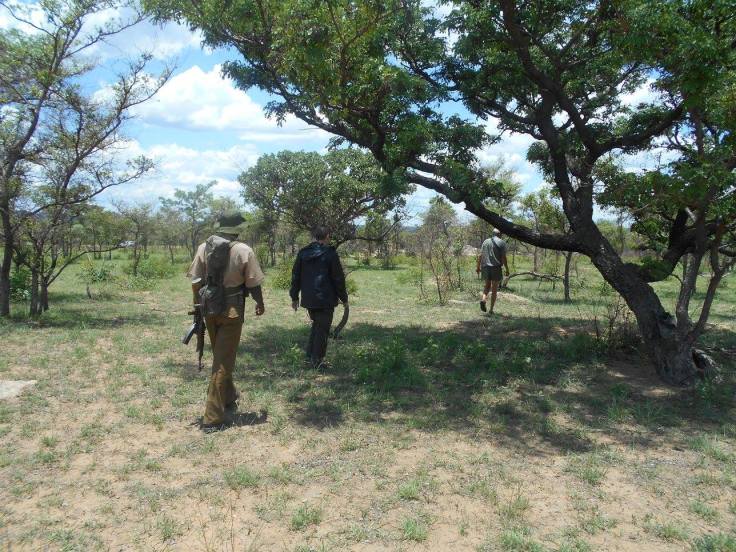
If there is such thing as a modern day dinosaur, the rhino comes close. It was like stepping back in time, as I watched these majestically ancient creatures move purposefully under the shade provided by the trees’ small branches. I found myself in awe of their presence. I tried not to breathe very loudly, as the rhino fixed his beady eye on me. If he wanted, the rhino could have plowed through the shade trees, easily uprooting them, before making his way to and through myself and my fellow travelers crouched low in the grass just a few yards away. However, the peaceful and friendly nature of these rhinos put me at ease, and I knew they were content to have me in their backyard, so long as I didn’t make too much noise! I fell in love with these easygoing creatures.
The issue is we are losing these animals.
One of the most magical but least expected highlights of my trip to Africa in December was the day I spent tracking the white rhinoceros near the Matopos with Ian Harmer of African Wanderer Safaris. I have always considered myself to have a respectable level of concern regarding animal and wildlife issues. However, spending a day with the rhinos of Zimbabwe made me passionate about the fight to save the rhino from extinction. I was stunned by what I learned—it is estimated two rhinos are killed each day, and poaching has grown considerably in the last 10 years. In 2007, 13 rhinos were poached in South Africa. In 2015, 1,215 rhinos were poached. At this rate, there will be no more rhinos left in the world within the next 10 years, in the wild or in captivity.

Why are the rhinos dying?
Rhinos across southern Africa are the target of organized poaching schemes driven by the economic forces of the illegal horn trade across Asia. Some Asian cultures believe rhino horn holds special medical power (everything from boosting male virility to curing cancer). The rhino horn can be worth up to twice its weight in gold in these markets. Poachers have advanced systems involving helicopters and infrared technology to track and kill the rhinos, often in the most inhumane ways possible. Ian shared a heartbreaking story from several months back about finding a rhino he had “grown up with” left for dead on the side of the road after the poachers had cut his face off to take his horn. In an effort to protect the rhinos in the fight against the poachers, rangers at the Matobo National Park carry machine guns and are mandated to shoot and kill suspected poachers on the spot.

Perhaps the biggest tragedy of all is that rhinos do not have to die or suffer to give up their horns. In fact, cutting a rhino horn is similar to clipping a human’s fingernails or toenails—if done correctly, the process is easy and pain-free. The staff at the Matobo National Park regularly cuts the horns of the rhinos in their park, in order to make them less of a target for poachers. This is unlike the elephant’s tusk, which is essentially a tooth instead of a fingernail. Elephants must be killed to extract the tusk.
How can we save the rhino?
The Convention on International Trade in Endangered Species (CITES) has been instrumental in working to protect the rhino and eliminate illegal horn trading. CITES meets every three years and has a standing committee specifically focused on the rhino. Recently, CITES has pushed for the government of Vietnam to conduct “consumer behavior research” in an effort to develop strategies to decrease demand for rhino horn, as well as to impose stiffer penalties for those participating in the illegal market. CITES has also mandated Mozambique, South Africa, and Zimbabwe to continue their efforts to coordinate along their borders to stop poachers, as well as to implement penalties for poachers more consistently. For example, in 2013, Mozambique issued a higher number of poaching fines than ever before, yet only 3% were paid.
The challenge is finding a solution that will prevent the rhinoceros from becoming extinct. It is quite difficult to change mindsets and alter economic pressures over a given period of time, and even more so when the time is severely limited given the rate that rhinos are being poached. What if the trade of the rhino horn became legal? Until 2009, domestic trading of rhino horn was legal in South Africa. It was made illegal in 2009 as a response to the spike in poaching. What about international trade of rhino horn? CITES banned this in 1977, in an effort to protect already dwindling rhino numbers. Despite these bans, the poaching issue has become considerably worse over the last decade, and we are now facing the possible extinction of the rhino.
Since it is painless to cut the horns of rhinos (or “dehorn” them), rhinos could be farmed like cattle and dehorned regularly, thus better protecting them from poachers and generating a profit for the farmers and benefitting the local economy. Also, poachers will be de-incentivized, as a legalized trade would increase supply and lower prices. However, there is always the risk that legalizing the trade could have the opposite effect of increasing demand, in which case poachers would still have inducement to poach. Also, given the demand for rhino horn is primarily in Asia, a ban on domestic trade of rhino horn is a non-issue, as there is really no domestic market. It seems a lift on the international trade ban would be the key driver of this solution.
CITES will have their triennial meeting this September in Johannesburg, South Africa. Without doubt, there will be continued debate on what policies would be most effective for protecting the rhino. I hope the leaders at CITES realize the current strategies have been ineffective, and time is running out for the rhino unless we change the game.





April 7, 2016 at 3:45 pm
great post
LikeLike